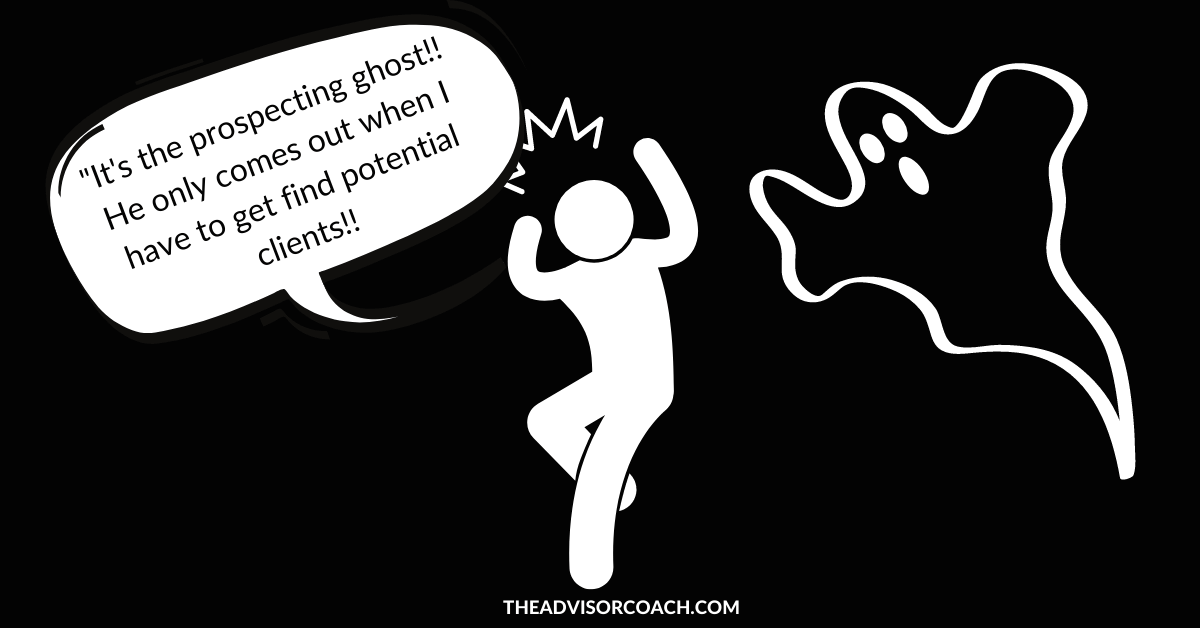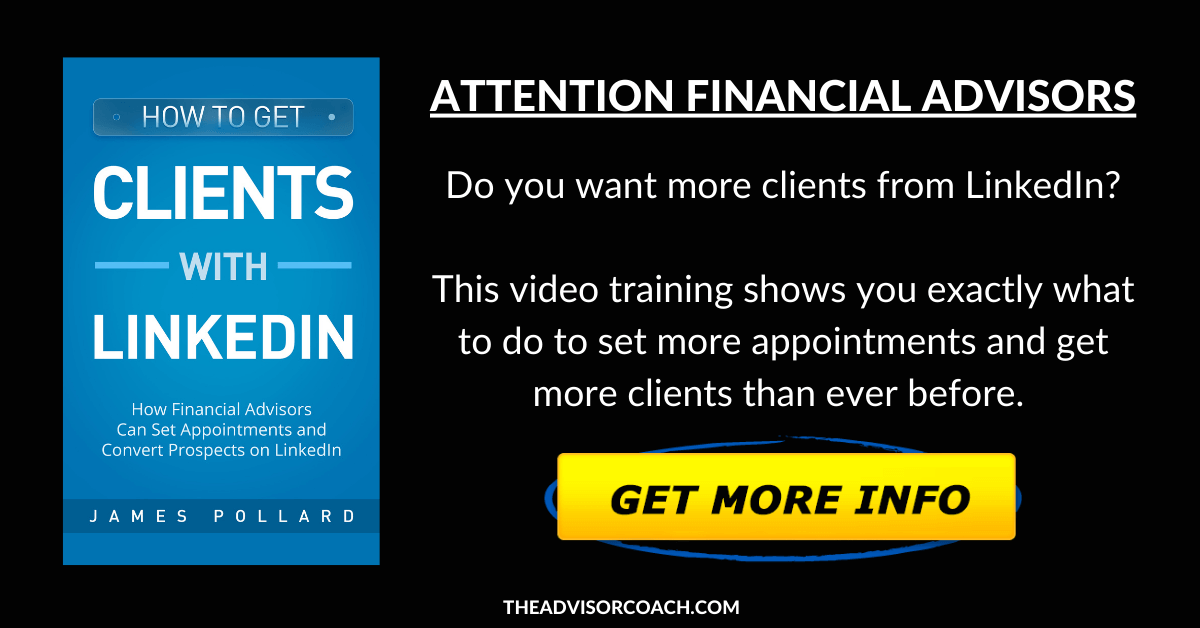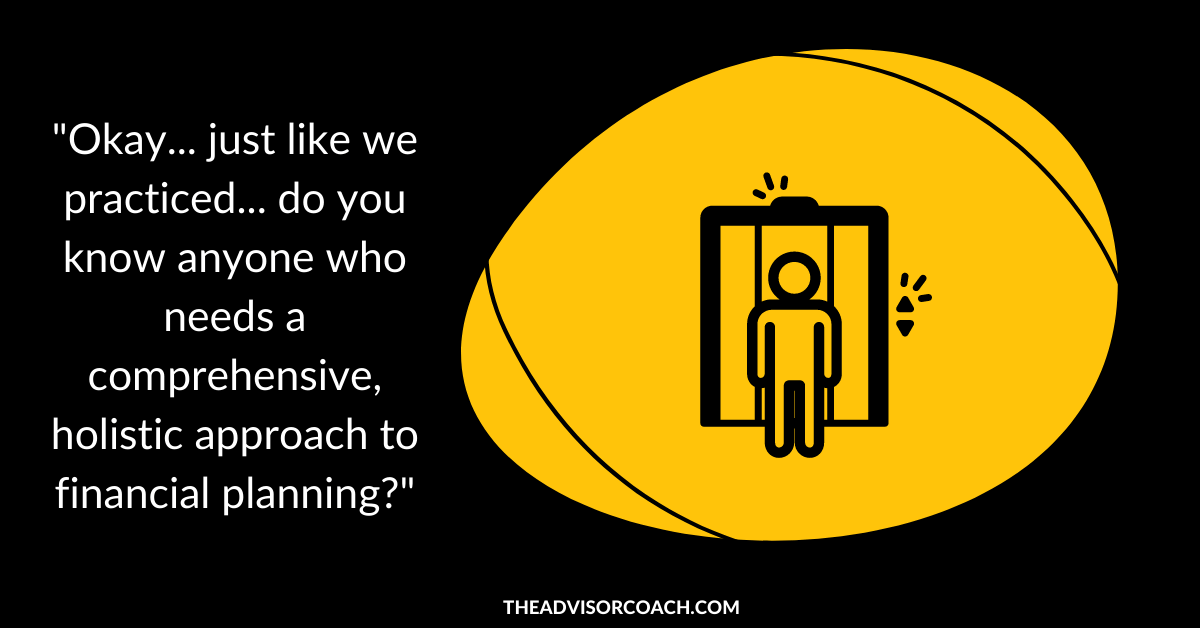15 Financial Advisor Prospecting Ideas & Techniques That Work!Effective prospecting ideas and techniques can be a lifesaver, especially since prospecting is the number one challenge financial advisors face. It’s tough to get in front of prospective clients.
I would argue prospecting is also the most important part of selling — nothing happens until somebody prospects new customers. It’s no wonder the most successful financial advisors are usually the ones who did the most prospecting all throughout their careers. In this post, I’m discussing financial advisor prospecting ideas you can put into practice immediately. In fact, these are some of the most powerful ways to generate leads. Instead of depending on purchased leads, learn how to develop your own prospecting leads. I’ve linked to quite a few articles throughout this post. To get the most out of it, read the linked resources; bookmark them if you have to. They’re there to give you a more detailed understanding of the various prospecting methods. Interested in something specific about prospecting as a financial advisor? Jump ahead to: The Importance of Prospecting
My definition of prospecting is the persistent and systematic method of developing and qualifying sales leads, which involves turning them into “prospects.” This is the backbone of your sales process.
One reason prospecting is so important is that attrition always works against you. Clients leave you, get divorced, or die, so your client base will slip through your fingers unless you prospect. Unless you want your revenue growth to slow down, prospecting should be your never-ending responsibility. Besides, you do yourself and your potential customers a disservice if you don’t prospect and let them know how your product or service can change their life. Prospecting Is Tough: Do These Steps First And Make It Suck Less...A major factor in your ability to get more clients as a financial advisor is to improve your prospecting skills.
There are countless coaches or consultants who peddle their digital courses filled with pipe dreams about how successful you can be without prospecting, but don’t let those overpriced “gurus” fool you. Unless you want to pay someone thousands of dollars to lie to you and possibly wreck your business, remember this free truth I shared on an episode of the Financial Advisor Marketing podcast: Prospecting is necessary to build a business. There’s a lot you can do to make it less painful, but getting rid of the practice entirely isn't one. Have you ever tried to build a book of business without it? One huge way you can transform your business is to prospect at the same time as you build a machine that lets those clients come to you — but to be a better prospector, you have to do it properly. Like author and sales trainer Jeffrey Gitomer said, “proper prospecting prevents poverty.” To do it properly plus make it suck less, you need to block out time to get it done, define your target market and prioritize referral marketing. Financial Advisor Prospecting Ideas
1. Overcome Your Fear
When it comes to prospecting, fear can kill your success before you even begin. The mere mention of prospecting can send a jolt of anxiety down a new financial advisor’s spine and make the veterans shudder.
For example, telling someone to "just ask" for a referral doesn't work. Advisors are afraid to ask for referrals, which is why I put together 51 Referral Marketing Tips for Financial Advisors. Financial advisors who avoid prospecting usually do so for two reasons: fear of rejection (we’ll talk about that later) and/or lack of preparation. You must be knowledgeable about your activities and the people that you’re trying to reach. Take some time to think about questions that leads will ask about you and your company. When you are thoroughly prepared for what will happen, you’ll be more confident in your approach. A special prospecting technique I want to share with you involves watching your self-talk. Whenever you catch yourself, for example, thinking “I hate prospecting”, try a new phrase such as “I gladly choose to prospect today.” One popular call reluctance book advocates wearing a rubber band around your wrist and snapping it every time you have a negative thought. Sounds cheesy, but it works. 2. Know Your Numbers
How many dials, on average, do you make per day? If you make 100 dials, how many people will you speak with? If you speak with 100 people, how many will agree to an appointment?
If you can’t answer those three questions, you are doing something wrong. Your entire life changes when you are able to predict your income, and you do that by knowing your numbers. If it takes you 100 phone calls to set 5 appointments and you convert one to a client, then you can predict your income, provided you know your average client’s contribution to the bottom line. Let’s say I get one client for every 100 phone calls and each client contributes $2,000 to my bottom line. If I want to gross $500,000 this year, all I need to focus on is making 25,000 phone calls (69 per day). It’s almost 90 per day if you work five days a week. The numbers will vary based on your situation, but you get the idea. Knowing your prospecting numbers is incredibly empowering, and it can also help you stay persistent. However, you want to be sure you're focused on the RIGHT metrics. Allow me to illustrate with a little story... Once upon a time, I was helping a financial advisor improve his seminar marketing. He was hellbent on getting as many people to attend his seminar as possible. He figured if he was going to be there anyway, he might as well leverage his time to be in front of as many people as possible. And while his heart was in the right place, that approach failed him because he was focused on the wrong metric. Your seminar attendance doesn't matter. Repeat after me: it DOESN'T matter. The only thing that matters is how many clients you get after the seminar. Too many advisors try to move heaven and earth for things that don't matter. They work so hard... but on the wrong things. Track your activity, number of appointments, number of clients, etc. - the "money metrics". :-) ALSO READ: 5 Ways to Generate Leads Without Cold Calling 3. Use a CRM
A CRM is one of the best ways to streamline your prospecting process. If you’re anything like me, your brain can’t possibly hold all the information you need when you’re prospecting. Using Customer Relationship Management software will let you know who you’ve already contacted, who you need to follow up with, what contact methods you’ve used, etc.
If you haven’t read it yet, check out my article on the best financial advisor CRM. 4. Learn How to Handle Rejection
Financial advisors will face rejection when prospecting. It’s a natural part of the sales process and it happens to everyone. The good news is that rejection is almost never about you. It’s about your offer. Some people will be interested, while others won’t. Remember, prospecting is simply about uncovering the prospects. If someone isn’t interested, he/she isn’t a prospect. It’s that simple.
Plus, remember that a “no” is a hundred times better than a “maybe”. People who struggle with handling rejection seem to think that “maybe” is a good thing because it’s not an outright rejection. The worst thing for a prospecting financial advisor is to get stuck in that weird “maybe” limbo. “No” allows you to move on to the next person who can say “yes”. Think about those gold prospectors who hiked out to California in 1849 – they got to the gold by sifting through all the dirt! That’s what you’re doing. You’re only going to find the gold by getting rid of all the dirt that accompanies it. As a financial advisor, you don’t have a cap on your income. Nobody can prevent you from helping more people and earning more money… except you. If you aren’t earning as much money as you’d like, I’m willing to bet that you have a marketing and prospecting problem. Imagine that you give a dog a bell. Every time the dog rings the bell, you give a treat. That bell wouldn’t stop ringing. Let’s say that after giving the dog a few dozen treats, you decide to hit the dog with a newspaper for ringing the bell. Ring-a-ling… whap! The dog might ring it a few times, hoping to get a treat, but after getting hit with the newspaper several times, the dog will stop ringing the bell. Now, I would never strike a dog, but my example serves a purpose… Because we're like the dog. We start off bright-eyed and hopeful. We learn that we don’t have a cap on our income. We can earn as much money as we please. The only caveat is that we must get rejected on a regular basis. That’s right - for every “yes” we receive from a prospect, we must hear “no” many more times. The “no” to us is like the newspaper to a dog. “I’m not interested”. Whap! “I already have an advisor.” Whap! Just like the dog will stop ringing the bell after so many “Whaps!”, financial advisors will stop marketing and prospecting. But this doesn’t change the unalterable truth that you can only get to “yes” by going through “no”. I’m going to link to a lot of resources in this article because I’ve written in-depth about a lot of these prospecting ideas. Here is a post I wrote about how to handle rejection in sales. 5. Have a Script
Don’t wing it. It’s important that you test and measure a variety of scripts to find the most effective one for you. Don’t ever copy someone else’s script verbatim. I know that, logically, it makes sense that if it works for one person it will work for you as well, but that’s not reality. I’ve seen two people use the exact same script and get drastically different results. If you don’t sound comfortable or fluent, you won’t get good results, so make a script that comes naturally for you.
One of the secrets to consistently generating revenue is to use a script for as much of the process as you can. If it can be scripted, it should be scripted. Perhaps the best reason for having a script is that it gives you something to say. The beginning of a conversation with a lead is usually the toughest. It’s difficult because you must take control of the conversation in a way that allows you to influence its direction. You must have a purpose for each contact. A script will keep you focused and consistent. Constantly adapt your scripts and test them against each other to improve your conversion ratios. However, I must warn you that NO script will make a difference if you're talking to the wrong people. If I had a dollar for every time a financial advisor told me he or she needed a “script!” to get clients, I would be a very wealthy man. Because so much attention in our industry has been spent on finding some magic set of words to say instead of dialing down on WHO is on the receiving end of those words. Case in point… If you’re talking to someone who has no interest in financial advice and loves do-it-yourself investing, no script will allow you to manage that person’s money. However, I’ve seen brand-new financial advisors pick a niche and once they get in front of niche, practically anything they say will result in an appointment. Why? Because if someone has a want/need for a financial advisor, getting them to talk with you is fairly easy. So, if you're a financial advisor and you want to become a better prospector, use a script AND make doubly sure that you're always talking to qualified prospects. ALSO READ: 5 Ways to Overcome Call Reluctance 6. Leverage Your Client ListLet's talk a little bit about Bruce Lee...
He's one of my favorite actors and he's best known for his roles in martial arts films. And when you think of martial arts, you think of punching with your fists and kicking with your feet, right? Well, in real life, Bruce Lee practiced Jeet Kune Do, which places more emphasis on striking with the elbows and knees. Why? Because you can hit WAY harder with them than you can with your fists and feet. Sure, a punch might knock someone out but a solid elbow hit could mean permanent damage. The secret lies in leverage. Leverage is defined as "to use something for maximum advantage". And just as critical self-defense skills are amplified with leverage, so is your business. Unfortunately, a lot of financial advisors fail to leverage their current client base as a prospecting strategy. Who do you like to work with? Identify your favorite clients – the ones who leave you feeling happy and energized. Try to figure out if there are any patterns. Check for similar personality traits, demographics, and values that can give you clues about your ideal prospects. Since prospecting is a tough activity, you should at least be prospecting for people you genuinely want to work with. Prospecting everyone is lazy and uninformed. Knowing who you WANT to work with and proactively targeting them is infinitely more effective. 7. Host a Client Appreciation Event
I wrote a lengthy article on this particular financial advisor prospecting idea. You can read the post here: 11 Awesome Client Appreciation Event Ideas for Financial Advisors.
The biggest mistake that I see financial advisors making with these events is that they only invite their current clients. Instead, you should invite both your current clients AND your dream prospects. When you invite your best prospects – the ones you really want to convert – you show them what it’s like to be your client. If they already have a financial advisor, you will be positioned as an extraordinarily strong backup. 8. Create Strategic Alliances Which Serve You
Another fantastic financial advisor prospecting idea is to develop a strong alliance with referral partners. This means developing relationships with estate attorneys, CPAs, and insurance agents (if you don’t do insurance). You can kill two birds with one stone by inviting your alliance members to speak (briefly, of course) at your client appreciation events.
Financial advisors who commit to building strategic alliances generate higher revenues than ones who don’t. It only takes a small number of strategic partners to really accelerate your business. But here’s an important newsflash: you can’t just approach three attorneys and three accountants and expect to build your “dream team”. This is a method that takes time and effort. Fortunately for you, that effort can pay off in spades. Imagine that you find a CPA with 100 clients. (In reality, the mean number of clients for a CPA is higher but I want to be conservative.) According to a report from the Economic Policy Institute, the mean retirement savings of all working-age families, which the EPI defines as those between 32 and 61 years old, is $95,776. (In reality, those older than 61 will have more money but, once again, I'm being conservative.) That means a referral relationship with that CPA represents more than $9.5 million in potential assets. Let's say you from four relationships just like that one. If you did, you'd have the potential to leverage $38 million in assets. Not so bad, right? Here's the general idea for getting more clients from CPAS. The actual details are explained here in 51 Referral Marketing Tips but this is a big-picture overview: First, get a big list of CPAs. Some CPAs will never give you referrals, period. It's the big fat ugly truth that advisors and "gurus" alike won't admit. It's also why if you're only trying to network with two or three CPAs, the odds are against you. When you start with a big list, you can network your way around and whittle it down to the top three or four who are most willing to work with you. Next, be candid with them. Don't beat around the bush and waste their time. Let them know you provide a lot of value to your clients (and SHOW them, don't just tell them) and let them know you're looking to bring that value to them as well. Then, make it clear who you serve best. One of the biggest reasons advisors don't get as many referrals as they'd like is because they're not CLEAR about what they want. For example, if I tell you that I work best with company executives, you immediately have a qualifying mechanism. If you run into an executive, you'll be much more likely to introduce him or her to me than if I told you I worked with anybody with a pulse. Members of your referral team need to know for whom you do your best work and how to recognize those people. Finally, nurture the relationship. This is probably the most important tip because building a referral relationship with a CPA will not happen overnight... and if it does, you probably don't want to work with that person anyway. I strongly recommend that you include CPAs in your CRM and establish predetermined follow-ups over the course of a year or two. Agree with them on how often you'll meet and talk about how things are going for you. Many of these relationships can - and will - go beyond a mere referral relationship. Patience is key. 9. Use Direct Mail
Direct mail is so underrated. The direct mail haters are the people who aren’t doing it the right way. It would take me about 170 hours (that’s over four forty-hour workweeks) to make 10,000 phone calls. I can get my message in 10,000 mailboxes in a single afternoon. Now you tell me which one you’d rather do.
Direct mail doesn’t work for small-ticket items because the math doesn’t work. I can’t spend $85 to send out 100 mailers and sell one or two $10 products. Financial services are different because the potential profit is so high. If your direct mail converted at 1% and you made a thousand bucks per client, wouldn’t you crank out as much mail as you could? Think about all the credit card offers you receive in the mail – do you think the big companies would be sending you so much stuff if it didn’t work? One of my favorite "secrets" for ratcheting up a direct mail campaign's results is lumpy mail. Lumpy mail is a term for mail that is, well, lumpy. It's got an odd shape or size, which means it stands out from everything else. It has a near-100% open rate, which means your prospecting message goes further. Because it's lumpy, your package is harder to stack. This means it can't get included in the normal piles of letters, postcards, and ads to throw away. Second, people enjoy receiving packages and are naturally curious about what's inside. Here are some lumpy mail ideas you can use:
If direct mail seems like a good fit for you, check out these five ways financial advisors can improve their direct mail marketing results. 10. Get Involved In Your Community
If you aren’t working with a big budget, you might want to commit more time than dollars. That’s where community involvement comes in. Volunteering and getting involved in local groups and associations is a great financial advisor prospecting technique because it helps you meet more people.
When you join an organization, you can meet like-minded people who may end up becoming clients themselves or referring other people to you. Be smart about this – don’t join an organization just to hawk your wares. Join something that you’re actually passionate about; if you don’t give two hoots about houses, don’t get involved with Habitat for Humanity. Edward Jones does a pretty good job with community involvement. They do a lot of stuff with United Way, the American Heart Association, and so on. Their financial advisors are often pushed to join Chambers of Commerce and get involved with toy and food drives. They know that getting involved in the community is good for business, so they do it! You should too. 11. Cold Calling
I can’t cover all the details of cold calling in this post, so I’m not going to try. There are hundreds of articles, books, and programs to help you become a better cold caller.
However, one of the dumbest things I catch people telling struggling financial advisors is to "make more calls". (Substitute "calls" for whatever you want - mailings, messages, emails, etc.) This is terrible advice because if a financial advisor is struggling, it's a symptom of a broken process... and trying to expand a broken process is a recipe for disaster. Imagine taking a bite of a spoiled sandwich and feeling sick. Eating the rest of the sandwich is NOT the answer. The answer is to go back and fix the process. For example, if you're saying the wrong things, "more calls" is not the answer. Or if you're targeting the wrong people, "more calls" won't work either. You have to fix the root cause. ALSO READ: 11 Lucrative Cold Calling Tips For Financial Advisors 12. Get On LinkedIn
LinkedIn is a goldmine. It’s no longer just a virtual resume or the place you go to find your next job. Read this: 4 LinkedIn Tips for Financial Advisors. At a minimum, you should be joining groups, messaging people, and getting involved. After all, it is a NETWORKING site!
If your time on LinkedIn is limited, try to find prospects with whom you share a common background. For example, if you both served in the same branch of the military, this can be an excellent conversation starter. The same goes for finding alumni, other association members, etc. I intentionally put this financial advisor prospecting idea after “cold calling” because LinkedIn is often touted as a way to eliminate cold calling forever. While I don’t agree right now, I’m not naïve enough to think that cold calling is as effective as it once was. With LinkedIn, you can almost always learn enough about someone to make a good cold call. Always be open with the people you call about having looked at their LinkedIn profiles. After all, they’re the ones who put their info online! If you use LinkedIn as a prospecting strategy in conjunction with cold calls, it’s a good way to break the ice and it shows that you put more effort than 95% of the other people calling your prospect. 13. Perfect Your Elevator Speech
Don’t put too much emphasis on
this, because it won’t change your life, but it can give you a slight
edge. If you’re at a networking event or cocktail party and someone asks
you what you do, you want to give an answer that helps you stand out.
An elevator speech is just a nice way to organize your thoughts. If you don’t have one in the back of your mind, you might find yourself rambling on, adding ideas here and there, or referring back to previous points… kind of how I write. Plus, it helps to keep you from getting caught off guard. ALSO READ: 9 Elevator Speech Tips for Financial Advisor 14. Leverage Your Website
Your website is a beautiful thing.
It can work for you 24/7. You can be on a golf course in Florida and
your website should still be sending warm leads directly to your inbox.
Your website is one of the best ways to find prospective clients for
financial advisors because people who get to the website are usually
“warm” leads. Imagine having some extra warm leads come your way each
and every day. Your website can do that for you.
I have a few resources about leveraging your website, so check them out: The Top 3 Must-Have SEO Tips for Financial Advisors 19 Tips to Improve Your Email Marketing 7 Reasons Why Most Financial Advisor Websites Are Terrible 15. Have a Niche
If you learn nothing else from me, please learn the importance of having a niche. Absolutely nothing will transform your business and grow your income quite like having a niche. The sad part is that because I give information away for free, people don’t value it much. I am literally telling you the most prospecting idea you can have – target a niche. If you want to pay me thousands of dollars to speak at your event, I’ll probably tell you the same stuff – target a niche.
Your time is limited, and the reality is that you’re going to have to find a way to get in touch with a LOT of people to build your business. I promise you that you’ll never have a huge book of business AND a 100% closing rate at the same time. You’ll have to do a lot of prospecting to build a pipeline that consistently throws off cash, but having a targeted niche will dramatically improve your efficiency and every single one of your sales ratios. You will spend less time dealing with clients and you’ll get more results from the prospecting activities you do. If you’re not convinced, here are seven reasons why financial advisors need a niche. Remember: Marketing And Prospecting Are NOT The Same...Before you take off and put these effective prospecting ideas to use, you have to understand the difference between prospecting and marketing. All prospecting is marketing, but not all marketing is prospecting.
Earlier I shared my definition for prospecting, which I consider to be all outbound marketing, where you reach out directly to potential clients to gauge their interest and filter out the leads who aren’t prospects. I view prospecting as a qualification game, whereas marketing refers to the broad action of promoting and selling products and services. That means your business is marketing and vice versa; you can’t have one without the other. If you want some of my favorite financial advisor marketing tips, check out this article: 27 Financial Advisor Marketing Ideas Marketing includes things such as email marketing, direct mail, LinkedIn and so on — but those are just the obvious strategies. What about how your office looks? Is that marketing? Yup, because it helps promote and sell your products or services. These small touches are often overlooked but leave a big impact in the marketing of your business:
Rather than only focus on creating new content for your website (which is important, too), look at your business as a whole, and ensure you aren’t leaving any marketing opportunities on the table. One of the biggest mistakes you can make is to think of marketing as an either/or activity. Marketing is a spectrum, people; not a line item in your budget you may or may not have spent — either something improves or hurts the odds of someone doing business with you. If you change the way you think about marketing, you’ll see it never stops. (Just like prospecting.) 😄 |







